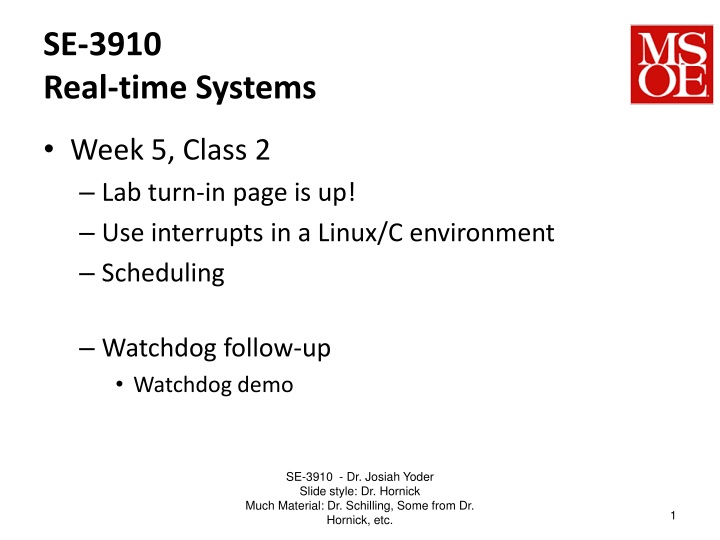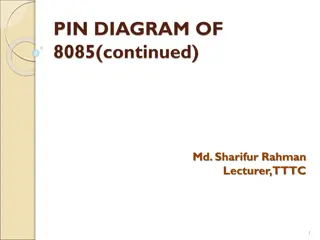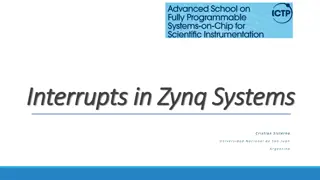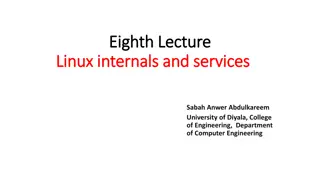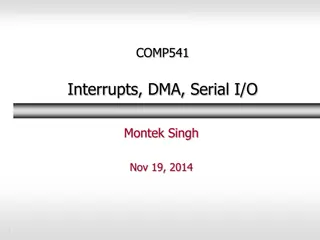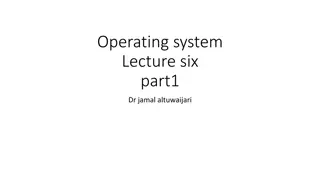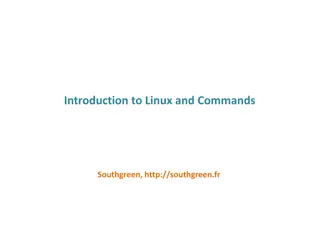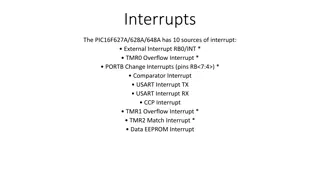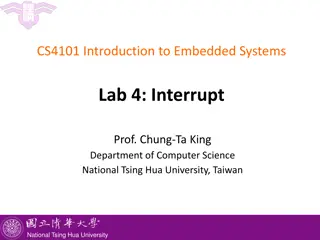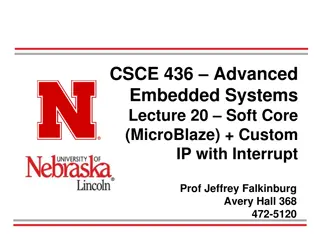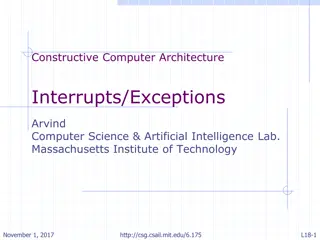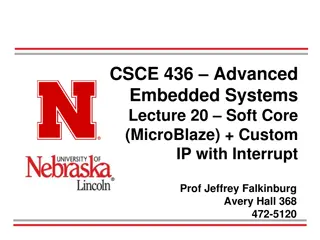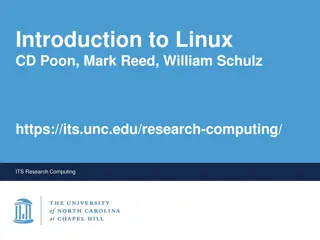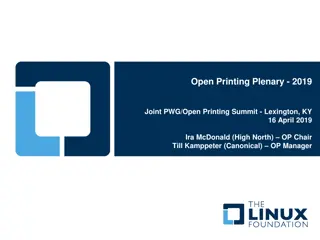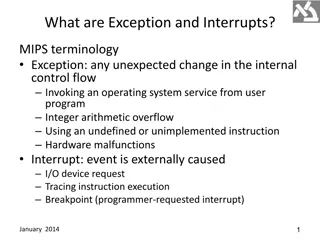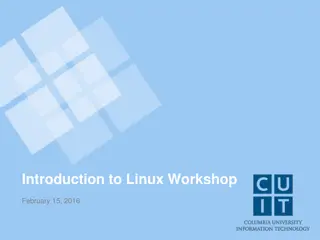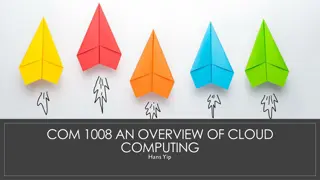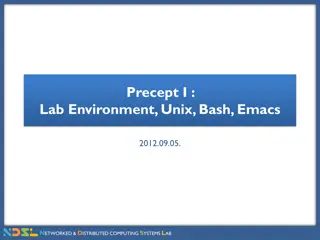Real-time Systems Week 5 Lab - Interrupts in Linux/C Environment
The use of interrupts in a Linux/C environment for real-time systems. Dive into topics like Watchdog Timer advantages, non-essential OS components, shell script behaviors, and scheduling approaches. Gain insights into task state diagrams, offline vs. runtime scheduling, and simplifying assumptions in real-time systems design.
Download Presentation

Please find below an Image/Link to download the presentation.
The content on the website is provided AS IS for your information and personal use only. It may not be sold, licensed, or shared on other websites without obtaining consent from the author.If you encounter any issues during the download, it is possible that the publisher has removed the file from their server.
You are allowed to download the files provided on this website for personal or commercial use, subject to the condition that they are used lawfully. All files are the property of their respective owners.
The content on the website is provided AS IS for your information and personal use only. It may not be sold, licensed, or shared on other websites without obtaining consent from the author.
E N D
Presentation Transcript
SE-3910 Real-time Systems Week 5, Class 2 Lab turn-in page is up! Use interrupts in a Linux/C environment Scheduling Watchdog follow-up Watchdog demo SE-3910 - Dr. Josiah Yoder Slide style: Dr. Hornick Much Material: Dr. Schilling, Some from Dr. Hornick, etc. 1
Quick Quiz! (1) What is an advantage of a Watchdog Timer? What is a disadvantage? How can we avoid the disadvantages? SE-3910 - Dr. Josiah Yoder Slide style: Dr. Hornick Much Material: Dr. Schilling 2
Quick Quiz! (2) Name two non-essential OS components and describe why each is non-essential. SE-3910 - Dr. Josiah Yoder Slide style: Dr. Hornick Much Material: Dr. Schilling 3
Quick Quiz (3) What does this shell script print? -------- script ------ echo var1: $1 echo var2: $2 echo Number of Arguments: $# ----------------------- when run as ./script John Doe Pete Stephens Nancy Drew SE-3910 - Dr. Josiah Yoder Slide style: Dr. Hornick Much Material: Dr. Schilling 4
Task State Diagram Laplante and Ovaske 4E p. 97 5
Scheduling Approaches Pre-runtime Create a feasible schedule offline prior to execution Requires prediction of the worst case performance for the system Takes into account context switch overhead Tries to avoid resource conflicts Runtime scheduling Priorities (fixed or dynamic) are assigned and resources are allocated Allows for tasks to be interrupted Allows for resources to be demanded periodically, aperiodically, or sporadically SE-3910 - Dr. Josiah Yoder Slide style: Dr. Hornick Much Material: Dr. Schilling 6
Scheduling Definitions Laplante and Ovaske 4E p. 98 7
(cont.) SE-3910 - Dr. Josiah Yoder Slide style: Dr. Hornick Much Material: Dr. Schilling 8
Simplifying Assumptions All tasks in the task set considered are strictly periodic. The relative deadline of a task is equal to its period. All tasks are independent; there are no precedence constraints. No task has any nonpreemptible section, and the cost of preemption is negligible. Only processing requirements are significant; memory and I/O requirements are negligible. SE-3910 - Dr. Josiah Yoder Slide style: Dr. Hornick Much Material: Dr. Schilling 9
Round-Robin Scheduling SE-3910 - Dr. Josiah Yoder Slide style: Dr. Hornick Much Material: Dr. Schilling 10
Round-Robin Scheduling with pre-emption SE-3910 - Dr. Josiah Yoder Slide style: Dr. Hornick Much Material: Dr. Schilling 11
Cyclic Code Scheduling Scheduling decisions are made periodically rather than arbitrarily Major cycle (hyperperiod) The minimum time required to execute tasks allocated to the CPU Equal to the least common multiple of the task periods Frames The locations where scheduling decisions are made No premption within frames SE-3910 - Dr. Josiah Yoder Slide style: Dr. Hornick Much Material: Dr. Schilling 12
Optimal Cyclic Code Scheduling Rate Monotonic Scheduling SE-3910 - Dr. Josiah Yoder Slide style: Dr. Hornick Much Material: Dr. Schilling 13
In-Class Exercise Calculation: What is the processor utilization for this problem? Based on RMA, what order will they execute and how will they execute? Hints: Draw release times, break up processing into multiple frames if needed. SE-3910 - Dr. Josiah Yoder Slide style: Dr. Hornick Much Material: Dr. Schilling 14
Rate-Monotonic Example SE-3910 - Dr. Josiah Yoder Slide style: Dr. Hornick Much Material: Dr. Schilling 15
RMA Guarantee Upper Bound for lower bound for range that will work 1 ? 1) ? ? (2 1 ? 1) = ??2 0.69 lim ? ? (2 SE-3910 - Dr. Josiah Yoder Slide style: Dr. Hornick Much Material: Dr. Schilling 16
Demo Connecting to Beaglebone [TODO] Perhaps another time! I may eventually put instructions for setting up a DHCP server on your laptop using connection sharing on website under Objectives Ask me if you don t find it when you need it You know my number. SE-3910 - Dr. Josiah Yoder Slide style: Dr. Hornick Much Material: Dr. Schilling 17
Demo Watchdog One prompt for i in `seq 0 1000`; do echo $(($i*10)); sleep 10; done; Another cat > /dev/watchdog SE-3910 - Dr. Josiah Yoder Slide style: Dr. Hornick Much Material: Dr. Schilling 18
